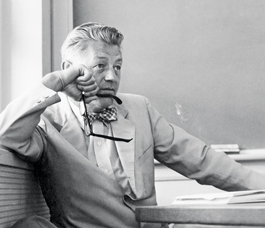home | metro silicon valley index | news | silicon valley | news article

Courtesy Stegner Estate
WRITER'S WRITER: Wallace Stegner in his heyday at Stanford's creative-writing program.
Western Words
By Michael S. Gant
WALLACE STEGNER is a prime counterexample to the adage that those who can't do, teach. In addition to writing the acclaimed novels Big Rock Candy Mountain, Angle of Repose (which won a Pulitzer) and The Spectator Bird, and the magnificent biography of explorer John Wesley Powell, Beyond the Hundredth Meridian, Stegner taught scores of aspiring authors how to write. Among his many students in the Stanford creative-writing program, which he started in the 1940s and ran for a quarter-century, were Edward Abbey, Wendell Berry, Ken Kesey, Larry McMurtry, Tillie Olsen and California poet laureate Al Young. Locally, readers will recognize the names of Santa Cruz novelist James D. Houston and Last Unicorn creator Peter S. Beagle. The legacy continues in the Stegner Fellowships, whose recent ranks include ZZ Packer, currently a guest teacher at SJSU.
Philip L. Fradkin has written a laudatory but measured new biography about the quintessential Western writer, Wallace Stegner and the American West (Knopf). Fradkin charts the peregrinations of Stegner (1909-1993) and his family, as his father, George, kept seeking the next boomtown on the horizon, from Iowa to North Dakota, from Saskatchewan to Salt Lake City. His upbringing left Stegner with a lingering psychic bone to pick with his father—which fueled his autobiographical novel Big Rock Candy Mountain—and a deep attachment to the vast Western landscape.
Stegner kept returning to the notion of the West as an arid land, where Eastern notions of development would cause environmental havoc. Fradkin details Stegner's commitment to environmentalism. It was Stegner who urged David Brower and the Sierra Club not to sacrifice Glen Canyon to the dam builders in the 1950s in a deal to save Dinosaur National Monument; Brower always regretted not listening to Stegner's advice. Stegner's Wilderness Letter of 1960, "produced in one afternoon of two-finger typing on his Remington manual typewriter," was a call to action that climaxed with the Wilderness Act of 1964. Stegner built his home in the then-empty Los Altos Hills in the late '40s and, in 1962, helped start the Committee for Green Foothills to fight an industrial park proposed for the area.
Fradkin offers a nuanced discussion of the literary imbroglio that erupted after the publication of Angle of Repose, in 1972. Stegner's inspiration for the novel was real-life mining man Arthur D. Foote and his wife, Mary Hallock Foote, a late-1800s author and artist. Stegner transformed them into the fictional couple Oliver and Susan Burling Ward. Stegner communicated, perhaps not clearly enough, with Foote's descendants and received permission from one of Foote's granddaughters to rummage freely through the family's archives looking for material. But some critics expressed shock that Stegner had quoted extensively without sufficient attribution from Mary Foote's letters. Feminists took Stegner to task for appropriating Foote's words and passing them off as his invention. Fradkin demonstrates that Stegner acted fairly based on his correspondence with the family, but that he perhaps didn't go far enough in clarifying his method for transmuting history into fiction. The Foote family, too, "made mistakes," as did Stegner's harshest critics. With time, the controversy seems to have abated, and Stegner is now often praised for his sympathetic treatment of his female characters.
PHILIP L. FRADKIN reads Wednesday (Feb. 20) at 6:30pm in the Terrace Room, Margaret Jacks Hall, Building 460, Stanford University; and on Thursday (Feb. 21) at 7:30pm at Kepler's, 1010 El Camino Real, Menlo Park. (650.324.4321)
Send a letter to the editor about this story.
|
|
|
|
|
|